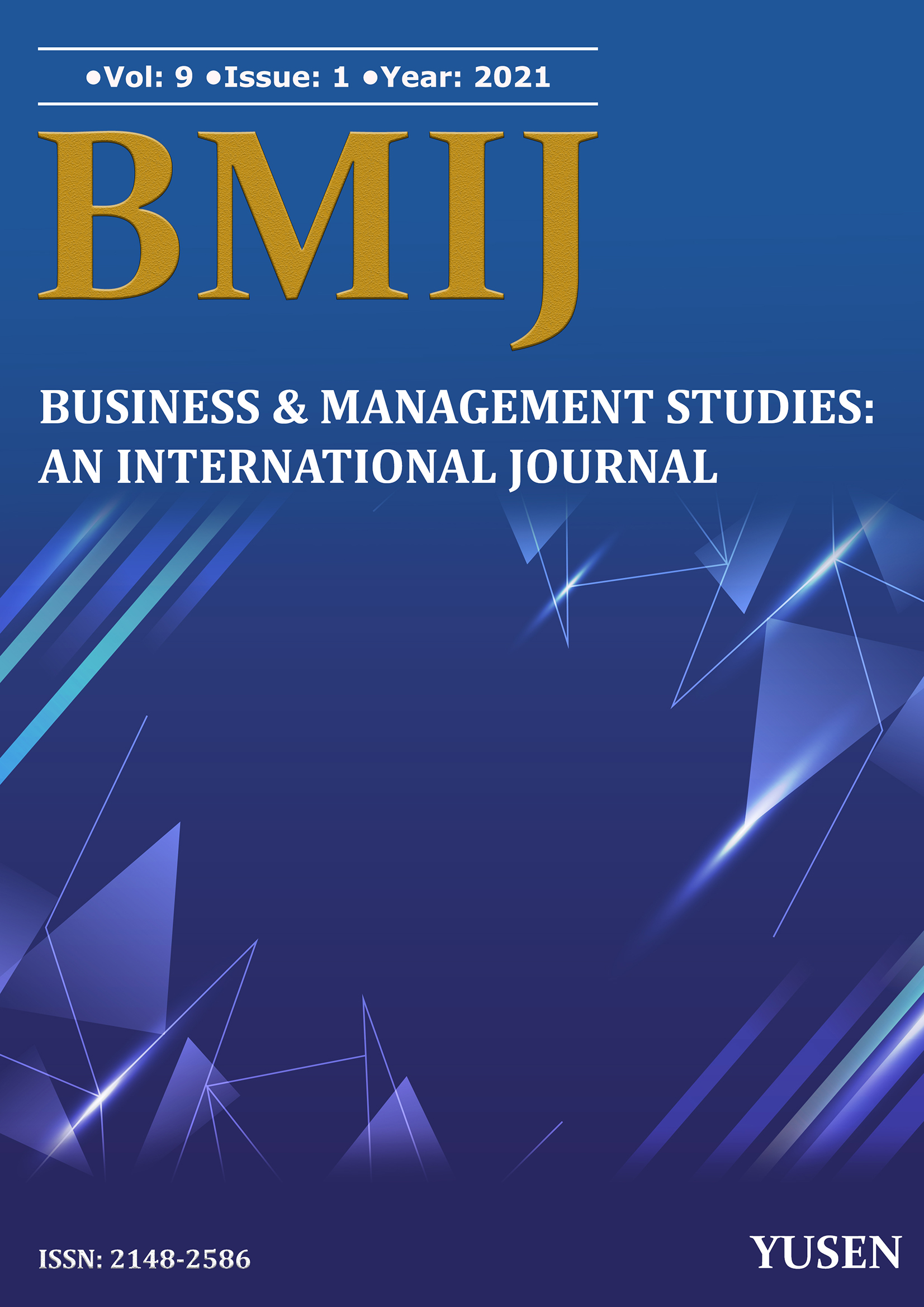Evaluation of the financial performance of businesses during the COVID-19 pandemic process with Entropy and MAIRCA methods: BIST food, beverage index example

Published 2021-03-25
Keywords
- Covid-19, Finansal Performans, MAIRCA
- Covid-19, Financial Performance, MAIRCA
How to Cite
Copyright (c) 2021 Ömer Kehribar- Ferhat Karademir- Samet Evci

This work is licensed under a Creative Commons Attribution-NonCommercial-NoDerivatives 4.0 International License.
Abstract
It is thought that due to the restrictions brought about by the COVID-19 pandemic, interest in basic needs has increased, and therefore, significantly, food businesses are affected by performance. In this study, the financial performances of the businesses registered in the Borsa Istanbul Food, Beverage (XGIDA) index were evaluated during the pandemic period. It is thought that it is essential to choose the relevant index since there are no studies for performance analysis in food businesses during the literature's pandemic process. The entropy that calculates criterion weighting and MAIRCA methods that rank the performance of alternatives were used in the study. According to the entropy method, it has been determined that the most crucial criterion is the Cash Ratio, and the least important one is the Asset Profitability Ratio. According to the MAIRCA method, it was determined that the best performing business was G7 (FRIGO), and the worst-performing business was G19 (TKURU).
Downloads
References
- Anthony, P., Behnoee, B., Hassanpour, M. & Pamucar, D. (2019). Financial Performance Evaluation of Seven Indian Chemical Companies. Decision Making: Application in Management and Engineering, 2(2), 81-99.
- Ayçin, E. & Güçlü, P. (2020). BIST Ticaret Endeksinde Yer Alan İşletmelerin Finansal Performanslarının Entropi ve MAIRCA Yöntemleri ile Değerlendirilmesi. Muhasebe ve Finansman Dergisi, (85), 287-312.
- Ayçin, E. (2018). BIST Menkul Kıymet Yatırım Ortaklıkları Endeksinde (XYORT) Yer Alan İşletmelerin Finansal Performanslarının Entropi ve Gri İlişkisel Analiz Bütünleşik Yaklaşımı ile Değerlendirilmesi. Dokuz Eylül Üniversitesi İktisadi ve İdari Bilimler Fakültesi Dergisi, 33(2), 595-622
- Bayrakdaroğlu, A. & Yalçın, N. (2012). Strategic Financial Performance Evaluation of the Turkish Companies Traded on ISE. Ege Akademik Bakış Dergisi, 12(4), 529-539.
- Çalış, N. & Sakarya, Ş. (2020). Finansal Performans ve Hisse Senedi Getirisi İlişkisi: BİST Bankacılık Endeksi Üzerine Bir İnceleme. MANAS Sosyal Araştırmalar Dergisi, 9 (2), 1046-1058
- Çanakçıoğlu, M. (2019). BIST Kimya, Petrol, Kauçuk ve Plastik Ürünler Sektöründeki İşletmelerin Finansal Performanslarının Hibrid ÇKKV Yaklaşımı Çerçevesinde Değerlendirilmesi. Beykoz Akademi Dergisi, 7(1), 123-152.
- Ersoy, N. (2020). Finansal Performansın Gri İlişkisel Analiz Yöntemi ile Değerlendirilmesi: Borsa İstanbul Ulaştırma Endeksi’ndeki Şirketler Üzerine Bir Araştırma. MUFAD Journal, 86, 223-246.
- Ertuğrul, İ. & Karakaşoğlu, N. (2009). Performance Evaluation of Turkish Cement Firms with Fuzzy Analytic Hierarchy Process and TOPSIS Methods. Expert Systems with Applications, 36(1), 702-715.
- Feng, C. M. & Wang, R. T. (2000). Performance Evaluation for Airlines Including the Consideration of Financial Ratios. Journal of Air Transport Management, 6, 133-142.
- Gigović, L., Pamučar, D., Bajić, Z. & Milićević, M. (2016). The Combination of Expert Judgment and GIS-MAIRCA Analysis for the Selection of Sites for Ammunition Depots. Sustainability, 8(4), 1-30.
- Ho, C. T. & Wu, Y. S. (2006). Benchmarking Performance Indicators for Banks. Benchmarking: An International Journal, 13(1/2), 147-159.
- Işık, Ö. (2019). ENTROPİ ve TOPSİS Yöntemleriyle Finansal Performans ile Pay Senedi Getirileri Arasındaki İlişkinin İncelenmesi. Kent Akademisi, 12(1), 200-213.
- Lee, P. T. W., Lin, C. W. & Shin, S. H. (2012). A Comparative Study on Financial Positions of Shipping Companies in Taiwan and Korea using Entropy and Grey Relation Analysis. Expert Systems with Applications, 39(5), 5649–5657.
- Li, X., Wang, K., Liu, L., Xin, J., Yang, H. & Gao, C. (2011). Application of The Entropy Weight and TOPSIS Method in Safety Evaluation of Coal Mines. Procedia Engineering, 26, 2085-2091.
- Orçun, Ç. (2019). Enerji Sektöründe WASPAS Yöntemiyle Performans Analizi. Bolu Abant İzzet Baysal Üniversitesi Sosyal Bilimler Enstitüsü Dergisi, 19(2), 439-453.
- Ömürbek, N., Karaatlı, M. & Balcı, H. F. (2016). Entropi Temelli MAUT ve SAW Yöntemleri ile Otomotiv Firmalarının Performans Değerlemesi. Dokuz Eylül Üniversitesi İktisadi ve İdari Bilimler Fakültesi Dergisi, 31(1), 227- 255.
- Pamucar, D. S., Tarle, S. P. & Parezanovic, T. (2018). New Hybrid Multi- Criteria Decision-Making DEMATEL-MAIRCA Model: Sustainable Selection of a Location for the Development of Multimodal Logistics Centre. Economic Research- Ekonomska istraživanja, 31(1), 1641-1665.
- Şahin, A. & Sarı, E. B. (2019). Entropi Tabanlı TOPSIS ve VIKOR Yöntemleriyle BIST-İmalat İşletmelerinin Finansal ve Borsa Performanslarının Karşılaştırılması. Muhasebe ve Vergi Uygulamaları Dergisi, 12(2), 255-270.
- Tetik, N. & Şahin, A. (2020). Katılım Bankalarının Finansal Performans Analizi. Atatürk Üniversitesi İktisadi ve İdari Bilimler Dergisi, 34, 293-314.
- Tseng, F. M., Chiu, Y. J. & Chen, J. S. (2009). Measuring Business Performance in the High-Tech Manufacturing Industry: A Case Study of Taiwan’s Large-Sized TFT-LCD Panel Companies. Omega, 37, 686-697.
- Ulutaş, A. (2018). Entropi Tabanlı EDAS Yöntemi ile Lojistik Firmalarının Performans Analizi. Uluslararası İktisadi ve İdari İncelemeler Dergisi, (23), 53-66.
- Wang, T. C. & Lee, H. D. (2009). Developing a Fuzzy TOPSIS Approach Based on Subjective Weights and Objective Weights. Expert Systems with Applications, 6(5), 8980-8985.
- Yurdakul, M. & İç, Y. (2003). Türk Otomotiv Firmalarının Performans Ölçümü ve Analizine Yönelik TOPSIS Yöntemini Kullanan Bir Örnek Çalışma. Gazi Üniversitesi Mühendislik-Mimarlık Fakültesi Dergisi, 18(1), 1-18.


